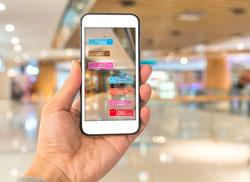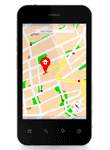 Have you ever walked into a mall and suddenly as you are passing some of your favorite stores, push notifications start blowing up your phone? They may say, “Come in and see our specials!” or “We just launched a new product – visit us in store to see what’s new!” Whatever the notification may say, it definitely grabs your attention and makes you think twice about visiting the store. This is called mobile location data, and more and more retailers are using it every day to attract new customers and to keep loyal customers coming back.
Have you ever walked into a mall and suddenly as you are passing some of your favorite stores, push notifications start blowing up your phone? They may say, “Come in and see our specials!” or “We just launched a new product – visit us in store to see what’s new!” Whatever the notification may say, it definitely grabs your attention and makes you think twice about visiting the store. This is called mobile location data, and more and more retailers are using it every day to attract new customers and to keep loyal customers coming back.
Mobile location data offers the possibility to gather real-time information about consumers through their smartphone, rather than trying to infer attributes and behaviors from other sources like store data, census surveys and IP addresses. Because of these possibilities, this type of marketing is on the rise. Blis, one of the companies who delivers location tracking data to retailers, did a report on how retailers are succeeding with new location-based digital initiatives.
“Because of location-based data, we have been able to re-allocate marketing dollars to locations based on traffic,” said Blis client Greg Lawville, in the report. “Now, we can pinpoint exactly when a member is near one of our locations and deliver timely content/offers.”
According to the study, 71 percent of retail marketers have some sort of location strategy to drive foot traffic and trigger location-based mobile advertising. Those who have this type of strategy reported a greater lift in store visits and overall conversations through the location-based strategies like retargeting and proximity tools like geofencing, the study found.
This mobile strategy can also help retailers better understand consumer behavior and what attracts them to an in-store purchase. Jamie Crespi, VP Marketing for Blis, said they charge on a CPM (cost per thousand) basis for the advertisement.
“On average, people use nine mobile apps daily that often employ location data to help them navigate their lives; we have come to expect our favorite apps and services to use location to be more relevant. Its changing human behavior, which means cutting-edge marketers are changing too,” according to a Lawless Research report.
This report also shows that location-based strategies helped boost traffic and sales. 87 percent of retailers created a positive customer experience using mobile location, and 83 percent said they saw higher customer engagement with the notifications. Many retailers are concerned about the Google and Facebook duopoly, so they are seeking alternatives, such as using mobile location data, to keep their customers and bring in new ones.
Google also uses location data with Android users, but it has shown to be an issue with consumers since their location is still being tracked even after they turn off the ‘location data’ option in settings. Google reported that they will stop this practice soon to ease people’s concerns.
Now, Google sets reminders and notifications. Reminders are triggered at a specified time before an event in your calendar starts. Notifications allow users to find out about changes to events in their calendar. Apple also shares these features with iPhone users, but neither corporation uses location-based data to send push notifications to users’ phones.
Blis is only one of the companies that supply location-based strategies for retailers, but it is definitely a worthwhile investment. Studies show that mobile location helps increase sales and customer engagement with the store. These numbers are expected to double by 2022, according to the Lawless Research report. If you want to see the same results in your store, it might be time to start utilizing location-based strategies.
